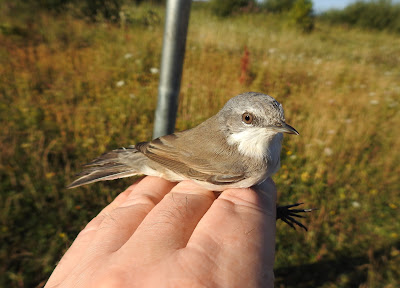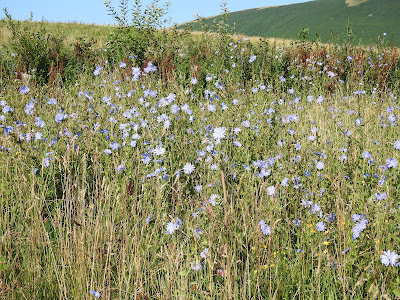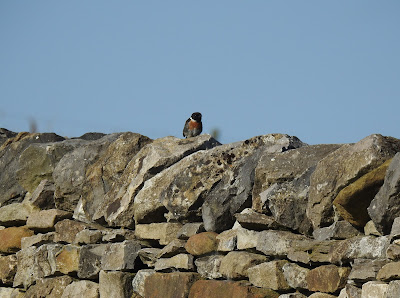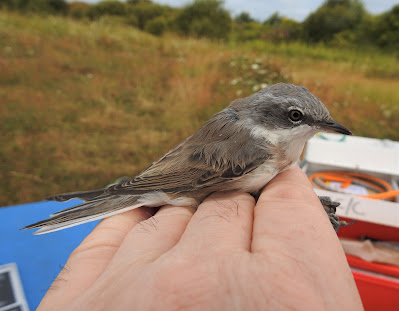The three weather forecast apps that I use suggested that the wind strength in terms of suitability for ringing was on the cusp this morning, and I hate forecasts like that. A bit stronger than forecast, it would be a waste of time setting nets, a bit less, then game on. What to do? I looked at the forecast for cloud conditions overnight, and it suggested a 'clear-out' morning rather than a 'grounded' morning, and I decided to go birding instead.
I went to the cemetery first, as the cemetery is only about 155 metres from the coast, and is often the first place you will find any grounded migrants on the peninsula. At 0630 I had 2 oktas cloud cover, with a light east-north-easterly wind. And there were no grounded migrants, just a little bit of vis with a small movement of Goldfinches heading south and west.
I then headed to another coastal location, the Mount, which is a little further from the coast than the cemetery, but still only 200 metres. As the name suggests, it is a small hill with some woody, parkland vegetation on it, and again it attracts migrants. Like the cemetery, it is well lit, and this adds to its attractiveness to nocturnal migrants. It was very quiet in the Mount with no grounded migrants and just a Grey Wagtail over that made it on to the pages of my notebook.
If I had gone ringing, it would have been to the Nature Park. The Nature Park is still fairly coastal, lying just 335 metres from the Wyre estuary, 1.7 km from the north coast (Morecambe Bay) and 2.4 km from the west (Irish Sea and Liverpool Bay) coast. Based on what I found, or didn't find, in the Cemetery and Mount, I felt justified that I had made the right decision, and would have caught very little.
I decided to head to the estuary and walk along the Quay towards the mouth of the river. Out on the mud of the quay few waders were feeding, with just 22 Redshanks, two Curlews and a single Oystercatcher. There was a flock of 42 Goldfinches, mainly juveniles, feeding on seed heads of a variety of plant species along the edge of the quay and the saltmarsh, and four House Sparrows and a couple of Linnets were amongst them.
On the superstructure of the former ferry port, a Peregrine was perched, but as I approached it headed off towards the mouth of the river. Walking back along the quay I heard the call of a Whimbrel, and two birds dropped onto the mud at the edge of the saltmarsh.
The only vis I had here was a single Tree Pipit over, and after a pleasant hour's walk I was back where I started.
Two out of the three weather apps that I check are suggesting that it will be very much too windy for ringing tomorrow morning, so it might be more of the same as today.
I was reading in the summer edition of the Buglife publication, 'The Buzz', that UK flying insects have declined by nearly 60% in less than twenty years. This came from the results of a citizen-science survey, led by Kent Wildlife Trust (KWT) and Buglife, that found that the abundance of flying insects in the UK has plummeted by nearly 60% over the last 17 years. As Buglife stated, this highlights a worrying trend and the crucial need for insect-focussed conservation research, nationwide.
The findings, published in a report published by KWT and Buglife, show that the number of insects sampled on vehicle number plates across the UK reduced by a frightening 59% between 2004 and 2021, and these findings are consistent with research which has widely reported declining trends in insect populations globally. Very worrying indeed!
England suffered the greatest decline, with 65% fewer insects recorded, Wales recorded 55% fewer insects and Scotland saw the smallest decline, but still with 28% fewer insects. The observed declines are statistically significant, and are indicative of a worrying decline. Why the difference between the three countries I'm not sure, but I can speculate that it is as a result of climate change (less of an effect in Scotland, combined with a northwards expansion of some insect populations) and habitat quality.
I'll leave the last words to Matt Shardlow, Chief Executive Officer at Buglife, and Paul Hadaway, Director of Conservation at KWT. Matt said this vital study suggests that the number of flying insects is declining by an average of 34% per decade, this is terrifying. We cannot put off action any longer, for the health and wellbeing of future generations this demands a political and a societal response, it is essential that we halt biodiversity decline - now!
Paul said the results from the Bugs Matter study should shock and concern us all. We are seeing declines in insects which reflect the enormous threats and loss of wildlife more broadly across the Country. These declines are happening at an alarming rate and without concerted action to address them we face a stark future. Insects and pollinators are fundamental to the health of our environment and rural economies. We need action for all our wildlife now by creating more and bigger areas of habitats, providing corridors through the landscape for wildlife and allowing nature space to recover.
As Paul said, this needs a political and societal response. The only way we are going to get a political response is through the ballot box, and it is probably time that the mainstream political parties receive a wake-up call! The societal response is very much down to us, and we can all do our bit to try and halt this decline before it is too late for the insects and us, but will the 'Love Island', soap opera and social media obsessed general public at large care enough to do something about it? We can only hope so!




















